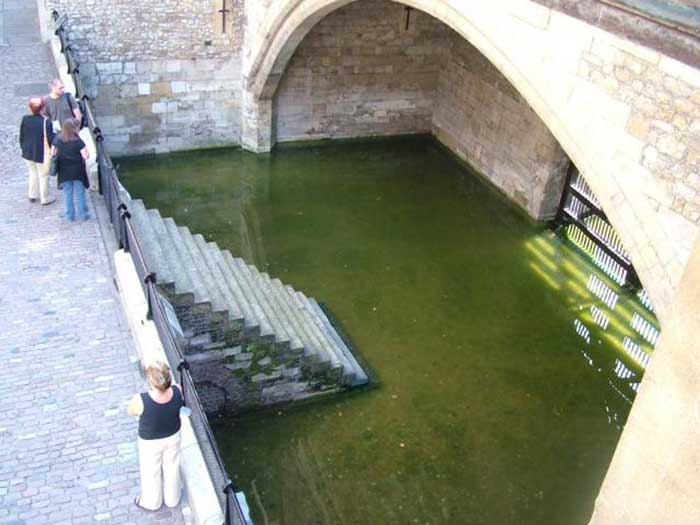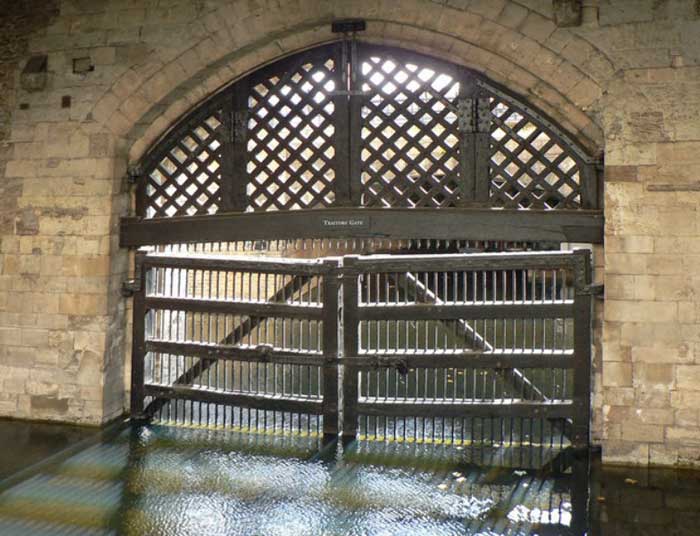
The Tower of London, the historic castle located on the north bank of the River Thames in central London, was basically built to provide additional royal accommodation and the infamous Traitors’ Gate is a water-gate entrance to the Tower. At the instance of King Edward I, the gate was designed and built by James of St George between 1275 and 1279 to provide a new door, by which King could arrive at the Tower by the Thames. The tower was his personal residence and he built rooms of his choice for his personal comfort. When he was there, he always had a boat to go out directly by the river, without having to go through the usual gates. In fact, the tower was a royal residence until the 17th century.
During the middle Ages, the character of the Tower of London changed completely and from a royal residence, it became a prison and the place of execution for politically related crimes, with most captives being put to death. Since the prisoners, accused of treason against the crown, were brought to the tower by barge along the Thames and through the water-gate entrance, it became infamous as the Traitors’ Gate. The first use of the name ‘Traitors’ Gate’ can be traced back to1544. While passing under the London Bridge, the prisoners got their fist shock, as they had to face the terrible sight of the heads of the executed prisoners displayed on pikes beneath the bridge. Over the centuries, hundreds of prisoners passed through the gate and many of them never returned alive. In the mid-19th century, the outer archway of the gate was renovated and bricked up because the water level had risen and the embankment works caused the river to run deeper.


Though the Traitor’ Gate and the Tower of London became infamous and earned a fearsome reputation, not all the prisoners of the Tower suffered terribly. In fact, prisoners of different status were treated in different ways. Rich and influential inmates were held in relative comfort, deprived only of their liberty. Some of them were allowed to bring personal servants and were even allowed to go out for hunting. However, those suspected or found guilty of treason or plotting against the monarch had to face the unavoidable sufferings.
Famous political prisoners such as: Edward Stafford, 3rd Duke of Buckingham (executed on on 17 May 1521), Queen Anne Boleyn (executed on the morning of Friday, 19 May 1536), Queen Catherine Howard (executed on13 February 1542), Lady Jane Grey (executed on the morning of 12 February 1554), Princess Elizabeth, the future Elizabeth I (imprisoned in the Tower of London on 18 March 1554,subsequently released), Sir Thomas More (executed on 6 July 1535), Edward Seymour, 1st Duke of Somerset (sent to the Tower of London in 1551, later released), Robert Devereux, second Earl of Essex (the last person to be beheaded in the Tower of London on 25 February 1601. It was reported to have taken three strokes by the executioner to complete the beheading), James Scott, 1st Duke of Monmouth (beheaded on 15 July 1685, on Tower Hill) - all had to enter the Tower by the fearsome Traitors' Gate, as they were brought by barge along the Thames.



Three queens of England: Anne Boleyn, second wife of Henry VIII; Catherine Howard, the fifth wife of Henry VIII and Lady Jane Grey, the ‘Nine Day’s Queen’ of England and Ireland from 10 July until 19 July 1553, were executed on the Tower Green.
In 1536, Queen Anne Boleyn, the second wife of King Henry VII, was arrested on charges of treason, adultery and incest. The Queen’s brother George Boleyn, Lord Rochford and Sir Henry Norris were also arrested on charges of adultery with the Queen. They were taken to the tower of London by barge and had to cross the entrance of the door of the traitors.
Catherine Howard, the fifth wife of Henry VIII was stripped of her title as queen on 23 November 1541, on the grounds of treason for committing adultery. Subsequently, she was transported to the Tower on Friday, 10 February 1542 and through the Traitors’ Gate she was led to her prison cell. She was beheaded on 13 February, at the age of 19.

After the death of Edward VI, his first cousin, Lady Jane Grey was proclaimed queen on 10 July 1553 and awaited coronation in the Tower of London. However, support for her half-sister Mary grew very quickly and most of Jane's supporters abandoned her. The Privy Council also decided to change sides and proclaimed Mary as queen on 19 July 1553, deposing Lady Jane. Her primary supporter, the Duke of Northumberland, was accused of treason and executed less than a month later. Jane was captivated as a prisoner at the Tower and was convicted of high treason in November 1553. Initially, Mary spared her life. But, after her father, Henry Grey became part of Wyatt’s rebellion Jane was viewed as a threat to the crown and was beheaded on 12 February 1554, along with her husband.
Queen Anne Boleyn’s daughter, Princess Elizabeth, the future Queen Elizabeth I, also had to pass through Traitors’ Gate. For her alleged involvement in the Wyatt Rebellion, she was arrested by the order of her half-sister, Queen Mary, the daughter of Henry VIII's first marriage to Catherine of Aragon. She was taken to the Tower on 18 March 1554, by barge. She was aware that her mother, Anne Boleyn, had been executed on the Tower Green when she was only three years old. It was raining heavily, when she was to land at the gate. At first, Elizabeth vehemently refused to land and angrily proclaiming that she was no traitor. However, finally she had to surrender helplessly, as she had no choice but to be led into the Tower. Nevertheless, subsequently she was released, as there was no evidence of Elizabeth's involvement in the plot.
Imprisonment and execution at the Tower continued intermittently until the German spy Josef Jakobs was shot by firing squad in 1941.